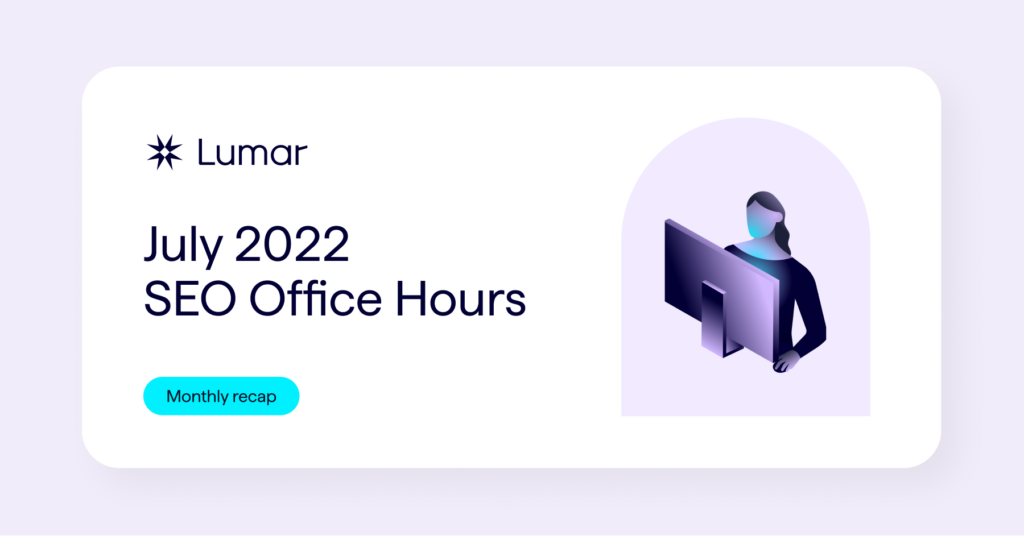We’re back with our monthly round-up of the key takeaways from Google Search Central’s SEO Office Hours. As always, you can browse our full library of SEO Office Hours takeaways, or read on below for advice from the most recent sessions.
PageSpeed Insights and Google Search Console data have different use cases — understand the differences between field data and lab data
A user asked about the difference between PageSpeed Insights (PSI) scores and the CrUX (Chrome User Experience Report) data found in Google Search Console (GSC). According to John, ultimately there’s no ‘correct’ number to use when it comes to speed and performance assessments — both PSI and GSC data can be used for different things.
The PageSpeed Insights score calculates a simplified overall score based on a number of assumptions about your website’s speed and the average user. Google Search Console, on the other hand, uses Core Web Vitals data and a sample of actual visitor experiences relating to speed, responsiveness, and interactivity.
John points out that there’s a difference between “field data” — numbers based on what real users have seen when they go to your website — and “lab data”, which is more of a theoretical view of your website, based on more generalized assumptions about the average user (with considerations for which devices most people will use, average internet speeds, etc.).
Both types of data are designed to give you insights into what users are experiencing or are likely to experience on your site.
John recommends using the field data in GSC to understand the current situation on your website and the lab data (namely individual tests you can run yourself) to optimize your site and try to improve things for the future. When you’re happy with the lab data you’re getting after making updates to your site, over time you will also automatically be collecting the field data in GSC, and can double-check the field data against the lab data to ensure that actual users are experiencing the improvements.
Skip directly to this part of the session video below:
Get more key takeaways on Google Search Console in our SEO Office Hours Library.
Linking to an HTTP site (as opposed to HTTPS) won’t damage your own domain’s organic search performance
According to John, there is no negative SEO impact to be had from linking to an external HTTP site (as opposed to HTTPS). If the webpage you’re linking to is on HTTP, there won’t be any negative repercussions for your own domain.
Skip directly to this part of the session video below:
Disavow files for poor-quality backlinks aren’t always necessary
Unless there’s a clear reason to use a disavow file (e.g. a manual action you’d otherwise take that can be resolved by disavowing specific domains), these days, it’s generally acceptable to remove your disavow file altogether. Google understands that poor quality links are a natural part of the web that most sites will accumulate over time, and now Google is better than ever at recognizing and ignoring instances of poor-quality backlinks. If you do delete an existing disavow file, it’s recommended to keep a copy of the document just in case you need to refer back to it later.
Skip directly to this part of the session video below:
Learn more about disavowing spammy backlinks in our SEO Office Hours Library.
Implementing structured data via Google Tag Manager is not ideal
Implementing structured data via Google Tag Manager (GTM) is usually fine, but in the long run, it’s still recommended to add the structured data to the page directly. Keeping schema and structured data directly on your site makes it easier for search engines to process and gives you more control. It also becomes easier to debug and maintain your structured data efforts as needed.
Skip directly to this part of the session video below:
Learn more about schema and structured data in our SEO Office Hours Library.
It’s okay if the same URL appears on multiple sitemap files
It’s fine to have the same URL included in multiple sitemap files. The only caveat is ensuring that there is no conflicting information being provided across the different sitemaps. For example, having a URL in a ‘regular’ sitemap and an hreflang-specific sitemap (for different language versions of your site) is perfectly acceptable, as long as any hreflang annotations given to that page are consistent across both sitemaps.
Skip directly to this part of the session video below:
Get more key takeaways on sitemaps in our SEO Office Hours Library.
Use the new “indexifembedded” robots meta tag to control the indexing of embedded content
A user asked how to block embedded videos from being indexed separately. John recommends using the new “indexifembedded” robots tag (in conjunction with standard noindex robots tags) to control which versions of the embedded videos are being indexed.
Skip directly to this part of the session video below:
Learn more about embedded content in our SEO Office Hours Library.








